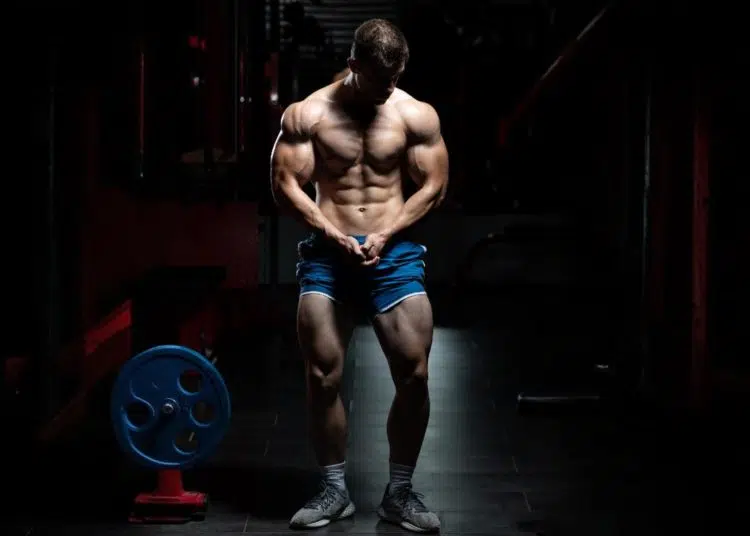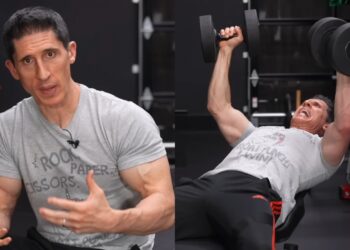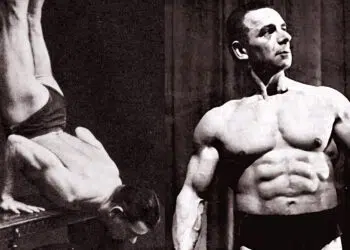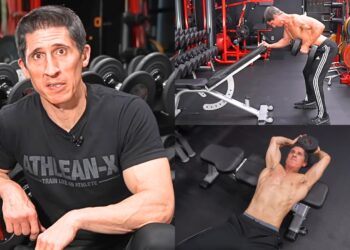Whenever I get a client with no prior training experience, we usually run a whole-body circuit for the first four weeks. This allows me to gauge their strength and prevent overtraining certain muscle groups so that they keep coming back fully rested.
However, I rarely do that myself, and I seldom utilize a full-body split with my clients who have been training for a while. However, that has changed.
For the past 30 days, I went all-in with a seven-day, no-rest, full-body split to see what would happen to my strength, muscle mass, body composition, and, most importantly, my recovery.
Here are the results.
My 30-Day Whole-Body Workout Split
Since I decided to skip rest days during this 30-day whole-body challenge, I needed to ensure that my workouts were customized for optimal performance.
Level Up Your Fitness: Join our 💪 strong community in Fitness Volt Newsletter. Get daily inspiration, expert-backed workouts, nutrition tips, the latest in strength sports, and the support you need to reach your goals. Subscribe for free!
I limited the training duration to 45 minutes because spending more than 10 hours in the gym during the week isn’t too convenient. Also, I had to make sure that I didn’t target the same muscles back-to-back so that I could give my body enough time to recover.
Finally, I had to ensure adequate weekly volume per muscle (or muscle group). While there is no such thing as the “ideal” number of weekly sets, anything between 8 and 20 sets seems to be the best for hypertrophy and strength-building, so that was my goal.
Having said all that, here’s everything I did for the past month.
Monday
| Exercise | Sets & Reps |
| Bench Press | 5 sets, 8–10 reps |
| Military Press | 4 sets, 8–10 reps |
| Back Squats | 4 sets, 8–10 reps |
| Leg Press | 5 sets, 8–10 reps |
| Tricep Dips | 4 sets, 8–10 reps |
| Plank | Until failure |
As you can see, Mondays were mostly focused on the chest, triceps, anterior delts, and quads. As for the core, I trained it every day, although not too heavily (also, there were two plank days), so I could recover in 24 hours.
I would start with five sets of benching to hit my chest and give some love to the front delts and triceps. After that, I would toast my front shoulder with the military press and move on to back squats and leg presses to train the quads. In the meantime, my triceps would rest up a bit, and I could finish them off with dips.
Tuesday
| Exercise | Sets & Reps |
| Pull-Ups | 4 sets, 8–10 reps |
| Seated Rows | 5 sets, 8–10 reps |
| Bicep Curls | 4 sets, 12–15 reps |
| RDLs | 5 sets, 8–-10 reps |
| Leg Curls | 4 sets, 12–15 reps |
| Med-Ball Russian Twists | 4 sets, 8–10 reps (per side) |
The second day of the week was focused on the back, hamstrings, and biceps.
As you can see, while I’m training the opposing muscles on a day-to-day basis (chest and back or quads and hamstrings), I am still following some of the standard training principles, where I’m training biceps with the back and triceps with chest because biceps and triceps get a significant stimulus as a secondary muscle with these compound lifts, so I don’t have to do too many isolation exercises, and I can focus on compound lifts.
As for bicep and leg curls, I would still train with about 70% of my one-rep max, but the last 4–5 reps would be long-length partials instead of a full range of motion.
Wednesday
| Exercise | Sets & Reps |
| Touch and Go Deadlifts | 4 sets, 10–12 reps |
| Bent Over Rows | 5 sets, 8–10 reps |
| Overhead Press | 5 sets, 8–10 reps |
| Hammer Curls | 4 sets, 8–10 reps |
| Lunges | 3 sets, 10–12 reps (per leg) |
| Cable Crunches | 5 sets, 12–15 reps |
Wednesday was all about the big compound movements (apart from the curls), but as you can see, I didn’t train for strength. I focused on hypertrophy. I would use slightly lighter weights than usual but focus on the technique and controlling the negative.
Also, I didn’t want to go heavy on the deadlifts because that would fatigue me, hindering the rest of the weekly workouts. So, I went with a reasonable weight and touch-and-go deadlifts to keep the intensity up.
Finally, Wednesday was also the first demanding core workout. Cable crunches are my go-to exercise for strengthening the core, but I couldn’t possibly tax my core so much every day of the week.
Thursday
| Exercise | Sets & Reps |
| Incline Bench Press | 5 sets, 8–10 reps |
| Lateral Raises | 4 sets, 8–10 reps |
| Skull Crushers | 4 sets, 8–10 reps |
| Front Squats | 4 sets, 10–12 reps |
| Machine Standing Calf Raises | 4 sets, 30 reps |
| Leg Raises | 4 sets, 8–10 reps |
Thursdays weren’t too focused on anything. Every exercise would tackle a different muscle group, but this had to be done at this point because the fatigue was starting to kick in despite the planning I did.
However, I did give it my all on the incline bench press. My chest was the only full-rested muscle on Thursday, so I would start with those, hit it really hard, and then move on to the rest.
As for the calves, if you’re wondering why I did so many reps, well, it’s just the way I train them, and I think you should, too.
Calves are super active during everyday life, and they’re extremely fatigue-resistant (do 30 reps, and you’ll see that you can do another 30 in less than a minute). They are also really stubborn and hard to grow. However, I figured out over the years that they respond to high volume much more than the load. Also, they seem to grow the most when trained in the stretched position, so I rarely go all the way up when I do them.
Friday
| Exercise | Sets & Reps |
| Lat Pulldowns | 5 sets, 8–10 reps |
| Single-Arm Dumbell Rows | 4 sets, 8–10 reps (per arm) |
| Preacher Curls | 5 sets, 10–12 reps |
| Hip Thrust | 4 sets, 8–10 reps |
| Stiff-Legged Deadlifts | 4 sets, 10–12 reps |
| Mountain Climbers | 3 sets, 10–15 reps |
As you can see, Fridays were the back-bicep-glute-hamstring days.
Going relatively easy the previous day really helped out on Fridays. I would be surprisingly fresh by the time I reached mountain climbers, so I was really happy with the design so far.
As you can see, I once again went with five sets for my biceps, but this time, it was mostly because whenever I do preacher curls, I keep the weight low to minimize the risk of injury.
Saturday
| Exercise | Sets & Reps |
| Back Squats | 4 sets, 10–12 reps |
| Deadlifts | 4 sets, 10–12 reps |
| Bench Press | 4 sets, 8–10 reps |
| Face Pulls | 4 sets, 12–15 reps |
| Tricep Dips | 4 sets, 8–10 reps |
| Cable Crunches | 4 sets, 12–15 reps |
Saturdays were super heavy because, at this point, I knew for sure I couldn’t go 30 days without rest. With that in mind, I decided to re-do the Wednesdays (to an extent) and just hit all major muscles at once and hit them hard.
Level Up Your Fitness: Join our 💪 strong community in Fitness Volt Newsletter. Get daily inspiration, expert-backed workouts, nutrition tips, the latest in strength sports, and the support you need to reach your goals. Subscribe for free!
I worked out with 80% of my one-rep max, so I would be genuinely toast by the time I finished. By the third set of every exercise, I would be 1–2 reps from muscular failure around the eighth rep, so this was probably my most hypertrophy-inducing workout of the week.
Sunday
| Exercise | Sets & Reps |
| Bodyweight Squats | 3 sets, 10 reps |
| Push-Ups | 3 sets, 10 reps |
| Step-Ups | 3 sets, 10 reps |
| Band Assisted Pull-Ups | 3 sets, 10 reps |
| Resistance Band Rows | 3 sets, 10 reps |
| Plank | 90 seconds |
I wouldn’t go to the gym on Sundays. I would wake up, eat breakfast, drink coffee, and do this bodyweight/active recovery workout at my house in about 30 minutes or so.
While this wasn’t a workout that was too demanding (but also not too easy), it was a workout that allowed me to go through this 30-day, no-rest, full-body split without too much trouble. It wouldn’t tax me too much, and I could rest up and go hard the day after.
What Are The Results of My 30-Day Whole Body Split?
If you’re expecting a drastic difference in my muscle mass or strength after a month of whole-body training — I’m sorry to disappoint you. While I noticed some things during the past month, I can’t say anything massive has happened.
However, I will still share my insights and experiences so you can see for yourself if this could be something you’d be interested in:
No Difference In Strength
I can’t say I was surprised I haven’t noticed any changes in strength. For the most part, I was training for hypertrophy, as training for strength would result in too much systemic fatigue, and I wouldn’t be able to train every day for the past 30 days.
If you want to get stronger, especially with compound lifts like squats and deadlifts, you must train harder than I did and employ progressive overload.
That said, if you’re a newbie or structure your whole-body workouts differently — you can expect phenomenal strength gains after a month of everyday whole-body training.
When discussing full-body splits, science-based fitness content creator and natural bodybuilder, Jeff Nippard cited a Norwegian study to explain why he’s a proponent of them.
“They split subjects into a group hitting their full body three days a week and a group hitting their full body six days a week. The rest of the program, including the weekly volume, was exactly the same. After 15 weeks of training, the six-day-per-week group got nearly twice as big and strong, increasing their lifts by a total of 10 percent versus five percent, while also gaining significantly more muscle.”
Slight Change In Body Composition
Despite training for hypertrophy, I didn’t experience any massive gains. That was expected, given my decade-long tenure in the gym. However, I did become a bit leaner.
While I didn’t have much fat to begin with, I did notice a slight reduction in tummy fat. I am certain that if I had been in a caloric deficit during this 30-day challenge, I could’ve lost 1–2% body fat with this approach. This means that if you’re looking to shed a bit of fat, train your whole body and maintain a slight calorie deficit (200–300 calories).
It Is Hard To Recover From This Type of Training
Even though I am in pretty great shape, recovering from these kinds of workouts isn’t easy. I wouldn’t recommend training every day, no matter what you’re doing — push-pull-legs, whole-body, bro-split, etc. Your muscles and central nervous system take time to recover, and that’s the truth.
Despite my best efforts to leave major muscle groups alone for 48–72 hours and train only 45 minutes daily, training every day isn’t ideal. While I was rarely sore, and my muscles would feel ready for training — I wouldn’t. I would feel tired after only a few days. If I hadn’t been doing bodyweight exercises on Sunday, I wouldn’t have made it past week two.
To make whole-body workouts viable, you probably need a full day’s rest every third day. I wouldn’t say training 3–4 times a week is ideal (even though it would yield superb results for many folks) because you wouldn’t be able to do enough weekly volume to stimulate muscle growth. That said, if that’s not your goal, and you just want to feel better and become stronger, doing two to three sessions per week could be more than enough.
Whole Body vs. Traditional Split? Training Splits Compared
I’m often asked if training the whole body is better than traditional splits. The truth is, there’s no right answer to that question because it all depends on what you want to achieve.
That said, objectively speaking, either one of these has its pros and cons and is better than the other in certain areas. With that in mind, let’s take a look at what the optimal approach would be for your particular needs.
Hypertrophy — Traditional Split
A traditional split like push-pull-legs is probably your best option if you want to build muscle. It provides you with more than enough weekly volume to maximize growth, and you often rest once every three days, giving you plenty of time to recover for the subsequent sessions.
Fat Loss — Either
Fat loss and weight loss will ultimately depend on the calories in versus calories out, so it really doesn’t matter how you train as long as you train. Every bit of physical activity will help a ton if you’re simply looking for something to keep you active and burn a few hundred extra calories during the week.
Strength — Traditional Split
While you can definitely train for strength, even if you’re training your whole body, that’s probably not the best way to go about it. When training for strength, you want to give it your all, which means you have to limit the number of reps and the number of exercises you do on a given day.
Recovery — Either
While I did say I couldn’t quite recover from this whole-body workout split, that’s only because I worked out every single day for four weeks. You’ll recover optimally if you train three to five times a week, and the same applies to any traditional split. If you structure your workouts properly, you shouldn’t have a hard time recovering.
Convenience — Whole Body
Training the whole body is super convenient. All you’ll do are compound lifts and an occasional isolation exercise for your arms or shoulders, so planning it is super easy. Also, since you’re doing compound exercises, you can’t really cram more than five to six exercises in a single session, so you’ll be done in less than 45 minutes most of the time.
Wrapping Up
If there’s one thing to take away from this, it’s that training the whole body works, and it works well. As long as you’re not overdoing it and utilize progressive overload, you will make excellent progress in due time.
Would I say this is the best approach to training? No, but then again, it could work well for some people. A whole-body split is perfect if you want to increase your work capacity, improve your aesthetics, lose weight, and improve your overall health.
References
- Baz-Valle E, Balsalobre-Fernández C, Alix-Fages C, Santos-Concejero J. A Systematic Review of The Effects of Different Resistance Training Volumes on Muscle Hypertrophy. J Hum Kinet. 2022 Feb 10;81:199-210. doi: 10.2478/hukin-2022-0017. PMID: 35291645; PMCID: PMC8884877.
- Helland C, Midttun M, Saeland F, Haugvad L, Schäfer Olstad D, Solberg PA, Paulsen G. A strength-oriented exercise session required more recovery time than a power-oriented exercise session with equal work. PeerJ. 2020 Sep 30;8:e10044. doi: 10.7717/peerj.10044. PMID: 33062443; PMCID: PMC7532781.










